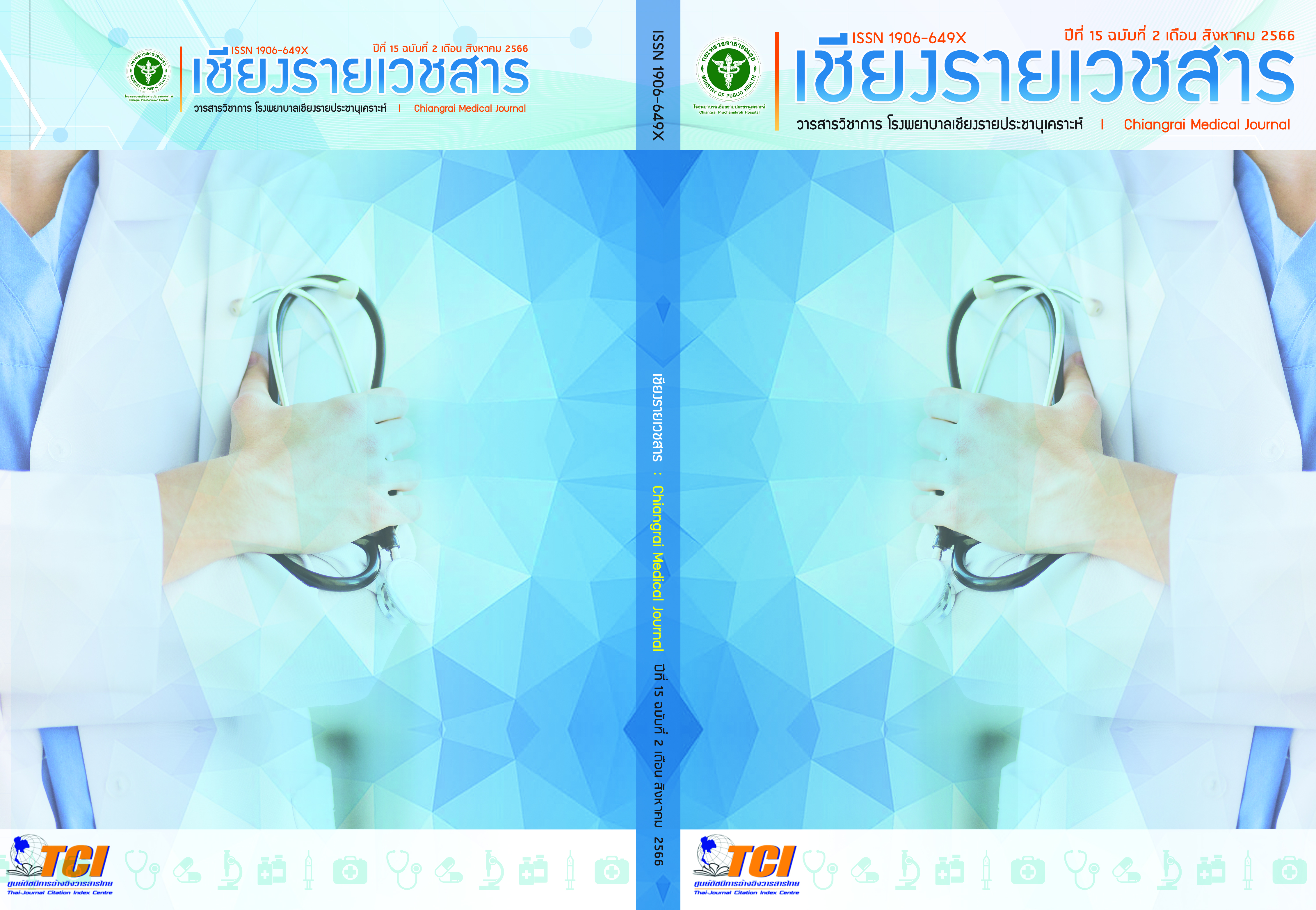ผลของการระบาดของโควิด-19 ต่อความชุกของโรคหนองในในอำเภอเมืองเชียงราย: การศึกษาย้อนหลัง 2 ปี
Main Article Content
บทคัดย่อ
ความเป็นมา โรคติดต่อทางเพศสัมพันธ์ เป็นปัญหาสำคัญทั่วโลก โดยเฉพาะโรคหนองใน ซึ่งมีอุบัติการณ์เพิ่มสูงขึ้น จาก 7.35 ในปี 2548 เป็น 14.74 ต่อแสนประชากรในปี 2561 จังหวัดเชียงรายพบความชุกของโรคหนองสูงสุดของประเทศ 44.73 คนต่อแสนประชากรในปี 2561 จากการระบาดของโควิด-19 ซึ่งส่งผลต่อวิถีชีวิตของผู้คนทั่วโลก และพบว่ามีผลต่อความชุกของโรคอื่นๆ รวมถึงโรคหนองใน
วัตถุประสงค์ (1) ศึกษาความชุกของโรคหนองในในอำเภอเมืองเชียงราย (2) เพื่อศึกษาความสัมพันธ์ของปัจจัยที่มีผลต่อระยะปลอดจากโรคหนองในในช่วงการระบาดโควิด-19
วิธีการศึกษา เป็นการศึกษาแบบ Cross-sectional จากการทบทวนข้อมูลผู้ป่วยโรคหนองในจากรายงาน 506 และเวชระเบียนผู้ป่วยนอกของโรงพยาบาลเชียงรายประชานุเคราะห์ปี 2562 และปี 2563 วิเคราะห์ความชุกของโรคหนองในในอำเภอเมืองเชียงรายรายปี และรายงานจำนวนผู้ป่วยต่อแสนประชากร การวิเคราะห์ข้อมูลใช้สถิติเชิงพรรณนา fisher’s exact probability test, T-test, Kaplan Meier survival curve และ Cox Proportional Hazards Regression Analysis กำหนดระดับนัยสําคัญทางสถิติที่ระดับ 0.05
ผลการศึกษา ในปี พ.ศ. 2562 พบความชุกของโรคหนองในในอำเภอเมืองเชียงรายเป็น 79.53 คนต่อแสนประชากร และในปี พ.ศ.2563 คิดเป็น 61.29 คนต่อแสนประชากร โดยอายุเฉลี่ยเป็น 23.04±0.72 ปี และ 22.72±7.21 ปีตามลำดับ ผู้ป่วยส่วนใหญ่เป็นเพศชาย มีสถานะภาพนักเรียน/นักศึกษามากกว่าครึ่ง เมื่อศึกษาระยะปลอดจากโรคหนองในกับการระบาดของโควิด-19 พบว่ามีความแตกต่างกันอย่างมีนัยสำคัญทางสถิติ โดยพบว่าการระบาดของโควิด-19 ในไทยพบผู้ป่วยโรคหนองในลดลง 0.71 เท่า (aHR 0.71; 95%CI 0.55,0.91; p 0.006) การเพิ่มของผู้ป่วยโควิด-19 ภายในประเทศทุกๆ 1 คนทำให้ผู้ป่วยโรคหนองในลดลงเป็น 0.99 เท่า (aHR 0.99; 95%CI 0.98,0.99; p <0.001) อายุของผู้ป่วยที่เพิ่มขึ้นทุกๆ 1 ปีพบผู้ป่วยโรคหนองในเพิ่มขึ้น 1.03 เท่า (aHR 1.03; 95%CI 1.01,1.05; p 0.004) ผู้ป่วยที่เคยมีประวัติติดเชื้อโรคหนองในมาก่อนมีโอกาสเป็นผู้ป่วยรายใหม่เป็น 1.38 เท่า (aHR 1.38; 95%CI 1.05,1.80; p 0.019) พบผู้ป่วยที่มีสถานภาพนักเรียน/นักศึกษา 1.35 เท่า (aHR 1.35; 95%CI 1.03,1.77; p 0.016)
สรุปและอภิปรายผล ความชุกของโรคหนองในในอำเภอเมืองเชียงรายในช่วงที่มีการระบาดของโควิด-19 ลดลงอย่างมีนัยสำคัญทางสถิติเมื่อเทียบกับช่วงที่ไม่มีการระบาด โดยผู้มีประวัติเป็นโรคหนองในมาก่อนและผู้ที่มีสถานภาพนักเรียน/นักศึกษา มีความสัมพันธ์กับระยะปลอดจากโรคหนองใน กล่าวคือมีโอกาสเป็นโรคหนองในสูงขึ้น ในช่วงสถานการณ์การระบาดของโควิด-19 อย่างไรก็ตามโรคหนองในยังคงเป็นปัญหาในพื้นที่ที่ต้องสร้างความตระหนักเพื่อให้เห็นถึงความสำคัญและควรมีการวางแผนป้องกันต่อไป
Article Details

อนุญาตภายใต้เงื่อนไข Creative Commons Attribution-NonCommercial-NoDerivatives 4.0 International License.
เอกสารอ้างอิง
Newman L, Rowley J, Vander Hoorn S, Wijesooriya NS, Unemo M, et al. Global estimates of the prevalence and incidence of four curable sexually transmitted infections in 2012 based on Ssstematic review and global reporting. PLoS One. 2015;10(12):e0143304.
World Health Organization. Report on global sexually transmitted infection surveillance 2018. Geneva: World Health. Organization; 2018.
Department of Disease Control, Ministry of Public Health. Annual epidemiological surveillance report 2018. Bangkok: Canna Graphic Limited; 2018. (in Thai)
Global health sector strategy on sexually transmitted infections 2016–2021: toward ending STIs. Geneva: World Health Organization; 2016.
Centers for Disease Control and Prevention. Sexually transmitted diseases treatment guidelines. MMWR Recomm Rep. 2015;64:1-37.
St Cyr S, Barbee L, Workowski KA, Bachmann LH, Pham C, Schlanger K, et al. Update to CDC's treatment guidelines for gonococcal infection, 2020. MMWR Morb Mortal Wkly Rep.
;69(50):1911-6.
Department of Disease Control, Ministry of Public Health. Gonococcal infection treatment guideline 2019. Bangkok: Agsorn graphic and design Part., Ltd.; 2019 (inThai )
Gonorrhea yearly situation report [Internet]. 2022 Nonthaburi: Bureau of Epidemiology,Department of Disease Control, Ministry of Public Health. Available from:http://doe.moph.go.th/surdata/disease.php?dcontent=old&ds=38.
Coronavirus disease (COVID-19) outbreak [Internet]. Geneva: World Health Organization; [cited 2021 Jan 31]. Available from: https://www.who.int/health-topics/coronavirus#tab=tab_1.
Coronavirus disease (COVID-19) pandemic [Internet]. Geneva: World Health Organization; [cited2021 Jan 31]. Available from: https://www.who.int/emergencies/diseases/novel-coronavirus-2019.
COVID-19: WHO’s Action in countries Thailand how a strong health system fights a pandemic September 2020 [Internet].Geneva: World Health Organization; 2020 [updated Sept 29; cited 2023
Mar 31]. Available from: https://www.who.int/docs/default-source/coronaviruse/country-case-studies/thailand-c19-case-study-20-september.pdf.
Gaspari V, Orioni G, Viviani F, Raone B, Lanzoni A, Bardazzi F. Does COVID-19 influence sexual behaviors? Dermatol Ther.
;33(6):e14004.
Cusini M, Benardon S, Vidoni G, Brignolo L, Veraldi S, Mandolini PL. Trend of main STIs during COVID-19 pandemic in Milan, Italy. Sex Transm Infect. 2021;97(2):99.
Shilo G, Mor Z. COVID-19 and the changes in the sexual behavior of men who have sex with men: results of an online survey. J Sex Med. 2020;17(10):1827-34.
van Bilsen WPH, Zimmermann HML, Boyd A, Coyer L, van der Hoek L, Kootstra NA, et al. Sexual behavior and its determinants during COVID-19 restrictions among men who have sex with men in Amsterdam. J Acquir Immune Defic Syndr. 2021;86(3):288-96.
Li G, Tang D, Song B, Wang C, Qunshan S, Xu C, et al. Impact of the COVID-19 pandemic on partner relationships and sexual and reproductive health: cross-sectional, online survey study. J Med Internet Res. 2020;22(8):e20961.
Pinto CN, Niles JK, Kaufman HW, Marlowe EM, Alagia DP, Chi G, et al. Impact of the COVID-19 pandemic on chlamydia and gonorrhea screening in the U.S. Am J Prev Med. 2021;61(3):386-93.
Crane MA, Popovic A, Stolbach AI, Ghanem KG. Reporting of sexually transmitted infections during the COVID-19 pandemic. Sex Transm Infect. 2021;97(2):101-2.
Kuitunen I, Ponkilainen V. COVID-19-related nationwide lockdown did not reduce the reported diagnoses of Chlamydia trachomatis and Neisseria gonorrhoeae in Finland. Sex Transm Infect. 2021;97(7):550.
Apalla Z, Lallas A, Mastraftsi S, Giannoukos A, Noukari D, Goula M, et al. Impact of COVID-19 pandemic on STIs in Greece. Sex Transm Infect. 2022;98(1):70.
de Miguel Buckley R, Trigo E, de la Calle-Prieto F, Arsuaga M, Díaz-Menéndez M. Social distancing to combat COVID-19 led to a marked decrease in food-borne infections and sexually transmitted diseases in Spain. J Travel Med. 2020;27(8):taaa134.
Steffen R, Lautenschlager S, Fehr J.Travel restrictions and lockdown during the COVID-19 pandemic-impact on notified infectious diseases in Switzerland. J Travel Med. 2020;27(8):taaa180.
Chia CC, Chao CM, Lai CC. Diagnoses of syphilis and HIV infection during the COVID-19 pandemic in Taiwan. Sex Transm Infect.
;97(4):319.


